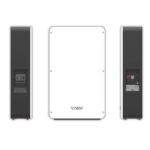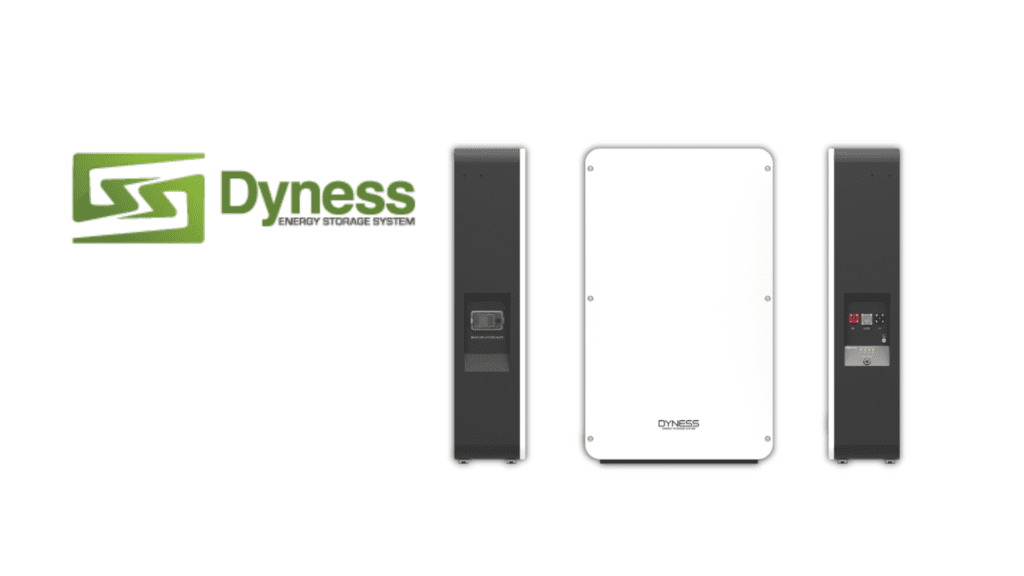Background on Dyness – Company History
Dyness is a Chinese company headquartered in Xi’an, the capital of Shaanxi Province. They started manufacturing battery storage solutions for residential use in 2017.
There’s limited information about this company on their website, however their flagship product for Dyness is the Powerbox, a modular system that enables expansion from 2.4KWh to 9.6KWh system in a single unit, and also run units in parallel for even more storage capacity.
It’s also important to note Dyness doesn’t have an office in Australia, so responsibility for warranty claims falls to the importer.
Basics of Dyness Battery
The Dyness Powerbox Battery is the company’s flagship product in the battery energy market, with a 2.4 kilowatt-hours nominal capacity and a 2.16 kilowatt-hours usable capacity as stated on their datasheet.
Also, unlike the Powerwall 2, the Dyness Powerbox doesn’t contain a battery inverter and so requires a compatible hybrid inverter to work.
The battery’s chemistry is lithium iron phosphate (LiFePO₄) which is the lithium chemistry most able to handle misuse.Its operating temperature is from 0 to 50ºC. This is good for a lithium battery and suitable for most of Australia.
It can be expanded in parallel with no limit in scalability according to their documentation. This put it well within the range suitable for most residential applications as well as commercial solar systems.
The Powerbox has an Ingress Protection (IP) rating of 65 which makes it suitable for both indoor and outdoor use.
It must be said that it appears the Powerbox is trying to look like a Powerwall with similar dimensions and design aesthetic. It’s also quite heavy at 47kg per module so be aware of that, especially if you’re connecting several modules together.
Here’s a list of compatible inverters that the Powerbox works with:
- Goodwe — China
- Victron — Netherlands
- Solis — China
- Imeon — France
- Luxpower — China
- Growatt — China
- GMDE — China
- Sofar — China
- Voltronic — China
- Ningbo Deye — China
Dyness Battery – Key Features
There are a number of features of the Dyness battery worth mentioning:
Operating Temperature Range
With a high operating temperature of between -20 to 50 degrees Celsius, gives you confidence that this battery will work efficiently and reliably in the temperature extremes that commonly occur in the Australian environment.
Flexible Use
The Dyness Powerbox can be used for both off-grid and hybrid system setups. This give you the consumer a lot of flexibility in how you use it. Whether you want to completely rely on developing a self contained solar power system or you want to retrofit it to an existing system, it caters to many different applications. Just be aware of the compatible inverters listed above.
90% Depth of Discharge
The Depth of Discharge (DoD) of the Powerbox is 90%. This puts it on par with some of Dyness’s competitors, namely Sonnen (90% DoD and Alpha ESS (90% DoD).
DoD is an important factor to account for when making a buying decision for a solar battery. It’s the percentage of the battery that has been discharged compared with it’s stated capacity. The higher the DoD, the more available stored energy you can use, and hence greater potential you’re gaining from it.
In relation to this, it’s not recommended that people discharge their batteries fully as it shortens their lifespan as they have a limited number of charge/discharge cycles. This is why a manufacturer will state the DoD to give you an indication of how much you can discharge it. In saying that it’s important to remember that there’s a correlation between the cycle life and the DoD, i.e. the more often you discharge the battery to it’s maximum DoD, the shorter its lifespan.
How Much do Dyness Batteries Cost?
We’ve reached out to Dyness for the wholesale cost of their batteries and will update this section when they respond back to us.
Compare quotes from up to 7 installers in your area now.
Australian warranty terms for Dyness Powerbox batteries
As per Dyness’s warranty documentation, the length of warranty is 10 years which commences from the sales date of the battery.
We’d like to note a few points on the warranty:
- Dyness warrants that the Products retains seventy percent (70%) of the Nominal Energy for ten (10) years from the Invoice Date. Or for a Minimum Through Output Energy which is calculated from the Invoice Date, whichever comes first.
- If the two parties disagree with whether the faulty equipment meets the warranty conditions, the products may be tested jointly by the ways approved by both parties, or the products shall be submitted to the third-party testing institutions recognized by both parties. Both parties can provide reasonable opinions on the test methods, basis and conclusions. The testing fee shall be borne by the Buyer first. If the testing result proves that the product meets the warranty conditions, the Seller shall pay the transportation fee and testing fee generated in full to the Buyer, and assume the responsibility for the faulty equipment warranty.
- Dyness reserves the right to refuse product warranty claims for lacking proper documentation and information. Claims under this Warranty must be made by notifying the Seller from whom Products was purchased within 2 weeks of appearance.
It’s not clear who the authorised resellers are in Australia for you to make a claim with.
To make a claim with Dyness directly here’s their contact details below:
Address: A9, Software new city 2, 156# Tiangu 8th road, High-tech zone, Xi’an, Shaanxi, China, 710065
Phone: +86 029 8954 0338
Mobile: +86 173 1249 0994
Fax: 029 8954 0338
Email: sales@dyness-tech.com
Read Dyness Powerbox’s Warranty Documentation here
Powerbox Specifications
| Powerbox | 4 x Powerbox (in parallel) | |
| Usable Capacity | 2.16kWh | 8.64kWh |
| Working Voltage | 40.5 -54V | |
| Cycle Life | 6000 | |
| Operating Temperature Range | -20 to 50 degrees Celsius | |
| Indoor/Outdoor | Both (IP65) | |
| Dimensions (H x W x D) | 928 x 555 x 210mm | 928 x 2,220 x 210mm |
| Weight | 47kg | 188kg |
| Scalability | No limit | |
| Warranty | 10 years | |
Read About Home Battery Government Schemes Across Australia
South Australia, New South Wales, Victoria, and Australian Capital Territory all currently have a home battery scheme in place.
The South Australian Home Battery Scheme enables eligible South Australian residents to receive up to $4,000 per installed battery.
The New South Wales Home Battery Scheme offers an interest-free loan up to $9000 for eligible households looking to install a solar battery.
Since 2008 our knowledge and sophisticated software has allowed over 300,000 Australian households and businesses to make a well-informed choice on their solar & battery installer.
- Why a big battery could be cheaper than a small battery with the federal rebate? - 19 June, 2025
- Heat Pump Costs – Solar Choice Price Index - 1 June, 2025
- Solar Panel Costs: Solar Choice Price Index | July 2025 - 1 June, 2025
